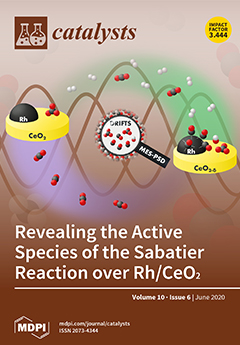Tungsten trioxide (WO
3) is a photocatalyst that has gained interest amongst researchers because of its non-toxicity, narrow band gap and superior charge transport. Due to its fast charge recombination, modification is vital to counteract this limitation. In this paper, we report on the fabrication of Mn-doped WO
3/SnS
2 nanoparticles, which were synthesised with the aim of minimising the recombination rates of the photogenerated species. The nanomaterials were characterised using spectroscopic techniques (UV-Vis-diffuse reflectance spectroscopy (DRS), Raman, XRD, photoluminescence (PL) and electrochemical impedance spectroscopy (EIS)) together with microscopic techniques (FESEM-EDS and high resolution transmission electron microscopy selected area electron diffraction (HRTEM-SAED)) to confirm the successful formation of Mn-WO
3/SnS
2 nanoparticles. The Mn-doped WO
3/SnS
2 composite was a mixture of monoclinic and hexagonal phases, confirmed by XRD and Raman analysis. The Mn-WO
3/SnS
2 heterojunction showed enhanced optical properties compared to those of the un-doped WO
3/SnS
2 nanoparticles, which confirms the successful charge separation. The Brunauer–Emmett–Teller (BET) analysis indicated that the nanoparticles were mesoporous as they exhibited a Type IV isotherm. These nanomaterials appeared as a mixture of rectangular rods and sheet-like shapes with an increased surface area (77.14 m
2/g) and pore volume (0.0641 cm
3/g). The electrochemical measurements indicated a high current density (0.030 mA/cm
2) and low charge transfer resistance (157.16 Ω) of the Mn-WO
3/SnS
2 heterojunction, which infers a high charge separation, also complemented by photoluminescence with low emission peak intensity. The Mott–Schottky (M-S) plot indicated a positive slope characteristic of an
n–
n heterojunction semiconductor, indicating that electrons are the major charge carriers. Thus, the efficiency of Mn-WO
3/SnS
2 heterojunction photocatalyst was monitored for the degradation of chlorpyrifos. The effects of pH (3–9), catalyst loading (0.1–2 g) and initial chlorpyrifos concentration (100 ppb–20 ppm) were studied. It was observed that the degradation was purely due to photocatalysis, as no loss of chlorpyrifos was observed within 30 min in the dark. Chlorpyrifos removal using Mn-WO
3/SnS
2 was performed at the optimum conditions of pH = 7, catalyst loading = 1 g and chlorpyrifos concentration = 1000 ppb in 90 min. The complete degradation of chlorpyrifos and its major degradation by-product 3,5,6-trichloropyridin-2-ol (TCP) was achieved. Kinetic studies deduced a second order reaction at 209 × 10
−3 M
−1s
−1.
Full article





